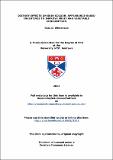Files in this item
Dietary effects on skin colour : appearance-based incentives to improve fruit and vegetable consumption
Item metadata
| dc.contributor.advisor | Ozakinci, Gozde | |
| dc.contributor.author | Whitehead, Ross David | |
| dc.coverage.spatial | 192 | en_US |
| dc.date.accessioned | 2013-03-01T10:34:51Z | |
| dc.date.available | 2013-03-01T10:34:51Z | |
| dc.date.issued | 2013-06-25 | |
| dc.identifier.uri | https://hdl.handle.net/10023/3371 | |
| dc.description.abstract | Poor diet precipitates significant social and economic burden, necessitating effective and economical dietary intervention strategies. Current population-level campaigns provide guidelines for living healthily and focus on the impact of lifestyle on chronic disease risk. Behavioural interventions which capitalise on individuals’ existing cognitions are likely to be more effective. A programme of work is presented here which evaluates the feasibility and efficacy of an appearance-based dietary intervention approach. This project aims to improve fruit and vegetable consumption by illustrating the associated benefits to skin appearance. The impact of fruit and vegetable consumption on skin colour is assessed (Chapter 6), corroborating previous between-subjects evidence which finds that dermal yellowness (CIE b*) is positively associated with fruit and vegetable intake. This work also discovers that modest within-subject dietary change is sufficient to perceptibly alter skin colour within six weeks (Chapter 7). Perceptual preferences are examined (Chapters 5 to 9), finding that optimally healthy skin colouration is that associated with increased fruit and vegetable consumption. Two behavioural intervention trials are conducted (Chapters 6 and 9) to evaluate whether visualising the impact of fruit and vegetable consumption on skin colour motivates dietary improvement. Relative to control groups, participants receiving an appearance-based intervention (in which the above effects are illustrated and explained) reported improvements in diet, particularly when illustrations were performed upon images of one’s own face. It may be valuable to disseminate such an intervention at a population level, though a number of further longitudinal studies are necessary to determine the wider effectiveness of this approach. | en_US |
| dc.language.iso | en | en_US |
| dc.publisher | University of St Andrews | |
| dc.rights | Creative Commons Attribution-NoDerivs 3.0 Unported | |
| dc.rights.uri | http://creativecommons.org/licenses/by-nd/3.0/ | |
| dc.subject | Fruit | en_US |
| dc.subject | Vegetables | en_US |
| dc.subject | Skin colour | en_US |
| dc.subject | Carotenoids | en_US |
| dc.subject | Intervention | en_US |
| dc.subject | Appearance | en_US |
| dc.subject | Diet | en_US |
| dc.subject | Dietary | en_US |
| dc.subject.lcc | RA427.8W5 | |
| dc.subject.lcsh | Health promotion | en_US |
| dc.subject.lcsh | Nutrition--Psychological aspects | en_US |
| dc.subject.lcsh | Human skin color--Psychological aspects | en_US |
| dc.subject.lcsh | Clinical health psychology | en_US |
| dc.subject.lcsh | Food preferences | en_US |
| dc.title | Dietary effects on skin colour : appearance-based incentives to improve fruit and vegetable consumption | en_US |
| dc.type | Thesis | en_US |
| dc.contributor.sponsor | Economic and Social Research Council (ESRC) | en_US |
| dc.contributor.sponsor | Unilever Research and Development USA | en_US |
| dc.type.qualificationlevel | Doctoral | en_US |
| dc.type.qualificationname | PhD Doctor of Philosophy | en_US |
| dc.publisher.institution | The University of St Andrews | en_US |
This item appears in the following Collection(s)
Except where otherwise noted within the work, this item's licence for re-use is described as Creative Commons Attribution-NoDerivs 3.0 Unported
Items in the St Andrews Research Repository are protected by copyright, with all rights reserved, unless otherwise indicated.


